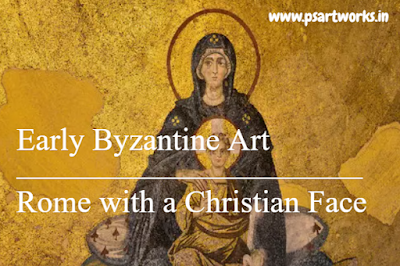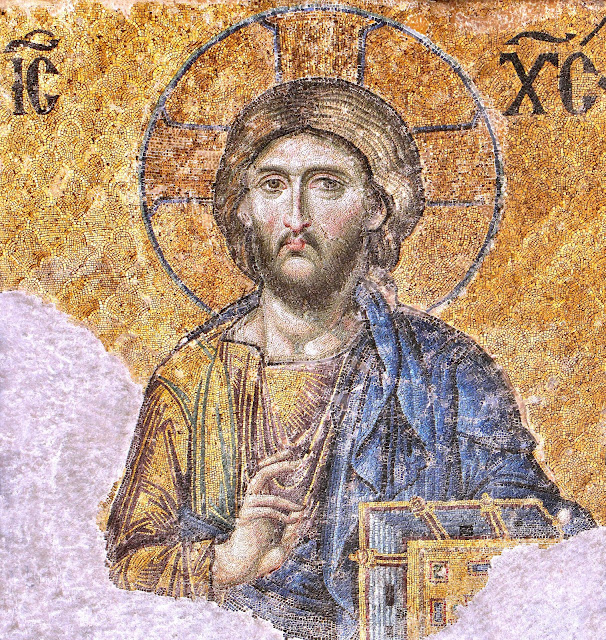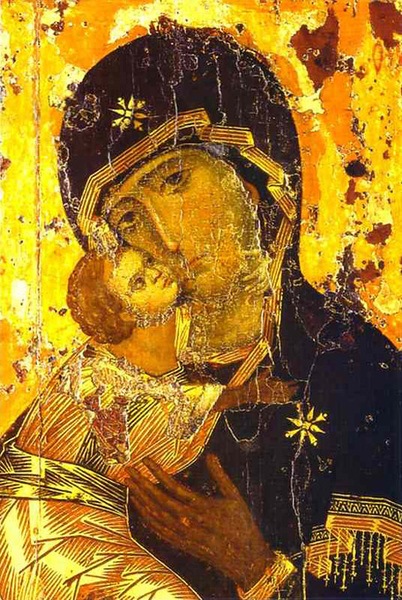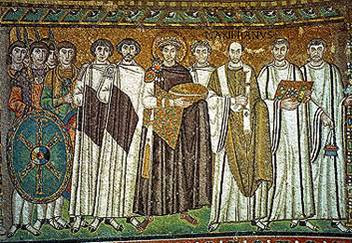Early Byzantine Art 330-527: Rome with a Christian Face?
To modern eyes, the life of Jesus Christ marks the turning point in world art history. He was born at Bethlehem before 4 BCE and baptized in the River Jordan in 28 or 29 CE. He died at Jerusalem in 30 or 33.
His short period of intensive public activity (one year at the least, five at the most) in the Roman province of Palestinawas charismatic enough to launch a new religion, distinctive for being monotheistic but without too remote a godhead.
While the growth of Christianity may not be the single cause of the fall of the Roman Empire in the West, its spread challenged existing social codes and attitudes and offers one clue to the radical transformations of Greco-Roman art.
Its citizens saw themselves as Romans, reborn after baptism into a Christian cosmos on earth.
The rest of the Mediterranean world soon imagined Constantinople as a kind of fantastic Eldorado.
Its history and art are the keys to understanding the processes of the ‘rebirth’ of ancient art, if that is how to describe the changes.
Yet this period and this culture are widely regarded as the most intractable—the most “‘Byzantine’—in the history of art.
This cannot be true: the survival of much of the art of this society, as well as its literature, offers exceptional opportunities for understanding the period and its aims and attitudes.
Many Byzantine churches with their original decoration survive, and in St Sophia, we can even stand in the great interior created in the sixth century, and see the same mosaics that the Byzantines, too, watched glittering in sunlight and candlelight.
In a sense, therefore, Byzantine art remains a living art, although it began 2,000 years ago.
This heterogeneous display, where one church may offer a single experience through art produced at different times and in different circumstances, is a problem for Western art history as it undercuts the standard methodologies which emphasize chronology and progress.
One perpetual issue is to recognize where there are continuities and where there are differences from the ancient world, and how to explain them.
This perception, too, needs assessment. It appears to dissolve the highly negative interpretation of Byzantine art first set out in 1550 by the painter Giorgio Vasari (1511-74) in his Lives of the Most Excellent Italian Architects, Painters, and Sculptors,which has since been the dominant view in much scholarship: that the arts of antiquity ‘died’ in the Dark Ages, only to be revived by Giotto in the thirteenth century.
- Jahangir Sabavala BiographySpread the loveThe Enigmatic Life and Art of Jahangir Sabavala: A Timeless Legacy Jahangir Sabavala | Biography | Life |…
- Ram Kumar BiographySpread the love Ram Kumar | Biography | Life | artworks Ram Kumar Ram Kumar, an important landscape…
- Famous Paintings by ManetSpread the love Most Famous Paintings By Edouard Manet Search Results Web res Music in The Tuileries Gardens …
- Art — An IntroductionSpread the love What is Art — An Introduction (Indian Context) Art is a technique to complete work…
- Krishna Reddy (b. 1925)Spread the love Krishna Reddy | Biography | Life | Artworks The oeuvre of Krishna Reddy, a pioneer print-maker…
- Lydia Mehta (b. 1923)Spread the love Lydia Mehta Biography, Life, Artworks The aesthetic enjoyment in the Indian tradition is based on and aimed…
- Somnath Hore (b. 1921)Spread the love Somnath Hore | Biography | Life | Artworks Somnath Hore, an eminent graphist, has…
- Dhan Raj Bhagat (1917-1988)Spread the love Dhan Raj Bhagat | Biography | Life | Artworks Sculpture By Dhanraj Bhagat Among the contemporary…
- Ramkinkar Vaij (1910-1980)Spread the love Ramkinkar Vaij | Biography | Life | Artworks Like Binode Behari, Ramkinkar also belonged to…
- Arpana Caur (b. 1954)Spread the love Arpana Caur | Biography | Life | Artworks Arpana Caur Biography Arpana Caur’s work symbolizes…
- Unseen Photos Of Indian Artists Arpana CaurSpread the love Arpana Caur Unseen Photos Read More About Famous…
- Jai Zharotia (b.1945)Spread the love Jai Zharotia | Biography | Life | Artworks Jai Zharotia Biography, Life, Artworks Jai Zharotia…
- Gogi Saroj Pal (b. 1945)Spread the love Gogi Saroj Pal | Biography | Life | Artworks Gogi Saroj Pal Biography The infatuation for…
- Vivan Sundaram (b. 1943)Spread the love Vivan Sundaram | Biography | Life | Artworks Though it was Engles who first used the…
- Manjit Bawa (b. 1941)Spread the love Manjit Bawa | Biography | Life | Artworks Manjit Bawa Biography,Life,Artworks According to J. Swaminathan, most…
- Jatin Das (b.1941)Spread the love Jatin Das | Biography | Life | Artworks Jatin Das & Nandita Das I recall a remark…
- Biren DeSpread the love Biren De | Biography | Life | Artworks Biren De Painting Biren De is…
- Gulam Mohammad Sheikh (b. 1937)Spread the love Gulam Mohammad Sheikh | Biography | Life | Artworks ‘Speechless City’ By Gulammohammed Sheikh The paintings of…
- Arpita Singh (b.1937)Spread the love Arpita Singh | Biography | Life | Artworks Arpita Singh The paintings of Arpita Singh, although somewhat…
- A Ramachandran (b. 1935)Spread the love A Ramachandran | Biography | Life | Artworks A Ramachandran A Ramachandran is essentially a…
- Om Prakash (b. 1932)Spread the love Om Prakash | Biography | Life | Artworks Om Prakash, in his more recent paintings…
- Shanti Dave (1931)Spread the love Shanti Dave | Biography | Life | Artworks The paintings of Shanti Dave, in encaustic and oils,…
- Bishamber Khanna (1930-1999)Spread the love Bishamber Khanna | Biography | Life | Artworks Bishamber Khanna is, perhaps, the only artist India…
- Jagdish Swaminathan (1928-1994)Spread the love Jagdish Swaminathan, Biography, Life, Artworks Jagdish Swaminathan in his paintings of the early 1990s seemed to continue…
- Anjolie Ela Menon (b. 1940)Spread the love Anjolie Ela Menon, Biography, Life, Artworks From the untamed exuberance of her early works, Anjolie Ela Menon’s…
- Satish GujralSpread the love Satish Gujral Biography, Life, Artworks Satish Gujral has emerged as…
- FUTURISMSpread the love Futurism | Meaning | Definition | History In several respects Futurism was unique among modern art movements….
- G.R. Santosh (1929-1997)Spread the love G.R. Santosh | Biography | Life | Artworks The aesthetic experience in India has traditionally been defined…
- Orphism | Meaning | Definition | HistorySpread the love Orphism | Meaning | Definition | History Orphism can briefly be described as a tendency towards abstract…
- PurismSpread the love Purism | Meaning | Definition | History Purism came after Cubism and was launched a book published…
- MINIMALISMSpread the love MINIMALISM When, in 1913, Malevich placed a black square on a white ground, claiming that ‘ art…
- Role of Folk Tradition in IndiaSpread the love Role of Folk Tradition in Indian Contemporary Art ABSTRACT India has always been known as the land…
- Leonardo da Vinci quotesSpread the love Quotes By Leonardo Da Vinci “Painting is poetry that is seen rather than felt, and poetry is a…
- OP ARTSpread the loveOP ART Op art abstract design The term optical or retinal is generally applied to those two- and-three-dimensional…
- Kinetic ArtSpread the love Kinetic Art | Meaning | Definition | History Cyril Barrett Kinetic Art means art which involves movement. (The…
- Philosophy of ArtSpread the loveIntentions and transparency in pictures and photographs Let us examine how photography complicates the analysis. You have no…
- Indian ArchitectureSpread the love A Brief Introduction to Indian Architecture (Ancient to Modern) The unique geography of India has contributed greatly…
- Gulzar: Biography | Life | Age | family |Career | legacySpread the love Gulzar: Biography | Life | Age | family |Career | legacy Gulzar Gulzar, one…
- Early Byzantine Art 330-527Spread the love Early Byzantine Art 330-527: Rome with a Christian Face? To modern eyes, the life of Jesus Christ…
- THE BAPTISM OF SURREALISMSpread the love THE BAPTISM OF SURREALISM Surrealism found its name almost as spontaneously as had Dada, the only difference…
- DADAISM OUTSIDE ZURICHSpread the love DADA OUTSIDE ZURICH A Brief History of Dada Francis Picabia brought to Paris the discoveries…
- BUDDHIST ROCK-CUT ARCHITECTURE-1Spread the love ROCK-CUT ARCHITECTURE. (A) THE MINAYANA BUDDHIST VIHARAS OR MONASTERIES. (B) THE ROCK ARCHITECTURE OF ORISSA (2nd Century…
- BUDDHIST ROCK-CUT ARCHITECTURE-2Spread the love ROCK-CUT ARCHITECTURE.(A) THE MINAYANA BUDDHIST VIHARAS OR MONASTERIES. (B) THE ROCK ARCHITECTURE OF ORISSA (2nd Century B.C.) …
- BUDDHIST ROCK-CUT ARCHITECTURE-3Spread the love ROCK-CUT ARCHITECTURE.(A) THE MINAYANA BUDDHIST VIHARAS OR MONASTERIES.(B) THE ROCK ARCHITECTURE OF ORISSA (2nd Century B.C.) The…
- Buddhist Architecture in India 1Spread the love INTRODUCTION: THE INDUS CIVILIZATION (e. B, C. 3000-2000)THE VEDIC CULTURE (c. B. C. 1500-800.) Many efforts have…
- 16 Most Famous Indian Folk Singers of All TimeSpread the love Most Famous Indian Folk Singers We all love music but everyone has their own choice that they…
- Buddhist Architecture in India 2Spread the love INTRODUCTION: THE INDUS CIVILIZATION (e. B, C. 3000-2000) THE VEDIC CULTURE (c. B. C. 1500-800.) The huts…
- BUILDING DURING THE RULE OF THE EARLY MAURYAN DYNASTY -1Spread the love BUILDING DURING THE RULE OF THE EARLY MAURYAN DYNASTY (ce. 400 B.C.) WOODEN ORIGINS A strong firm government-administered…
- BUILDING DURING THE RULE OF THE EARLY MAURYAN DYNASTY -2Spread the love BUILDING DURING THE RULE OF THE EARLY MAURYAN DYNASTY (ce. 400 B.C.) WOODEN ORIGINS Apart from the fortifications…
- ASOKA, AND THE BEGINNINGS OF THE BUDDHIST SCHOOL -1Spread the love ASOKA, AND THE BEGINNINGS OF THE BUDDHIST SCHOOL (cir. B.C. 250) Up to the middle of the third…
- ASOKA, AND THE BEGINNINGS OF THE BUDDHIST SCHOOL -2Spread the love ASOKA, AND THE BEGINNINGS OF THE BUDDHIST SCHOOL (cir. B.C. 250) In these circumstances it is not difficult…
- Papon Biography | Life | Family | Profession | Real Name | ControversySpread the lovePapon Biography | Life | Family | Profession | Real Name | Controversy Papon is an Assamese singer…
- Most Famous Grffiti Art on the Streets of DelhiSpread the loveMost Famous Graffiti Art on the Streets of Delhi Street art is an incredible art form that can…
- paintings of famous European painter Vincent Willem van GoghSpread the love Famous Paintings Of Van Gogh Van Gogh never got as much recognition in his life as after…
- Amazing Pencil DrawingSpread the love Amazing pencil drawings: Graphite has always been the favourite medium for artists to portray their creativity. Best…
- Hyperrealistic Pencil Drawings | Realistic Drawings For Beginners | Image of Hyper-Realistic DrawingSpread the love100+ Shockingly Best Hyper-Realistic Pencil Drawings & Images Hyperrealistic pencil drawings are quite an artistic feat. It is…
- Hand Painted Wine GlassesSpread the love Painted Wine Glasses | Wine Glass Painting Images | Glass Painting Images Hand Painted Wine Glass Painted…
- Hand Painted Wine Glasses For Gift & occasionsSpread the loveHand Painted Wine Glasses | DIY Hand Painted Wine Glasses | Hand Painted Wine Glasses Ideas | Hand Painted Wine…
- flower Hand Painted Wine GlassesSpread the loveFind elegant, floral hand-painted wine glasses and other hand-painted glassware … drink and your favorite summer flowers on…
- THE WAR — THE STIMULUS FOR DADASpread the love THE WAR — THE STIMULUS FOR DADA THE WAR — THE STIMULUS FOR DADA The art of…
- Trees Hand Painted Wine GlassesSpread the love Hand-painted Wine glasses are sure to bring a smile to your face! Each glass is hand-painted. Art…
- 10 Most Famous Leonardo da Vinci Quotes | Memorable Quotes By Leonardo da VinciSpread the loveLeonardo da Vinci Quotes |Leonardo Di Vinci Quotes About Life & Art | Inspirational Leonardo da Vinci Quotes | Leonardo…
- Hand Painted Wine Glasses To Gift On Every occasionSpread the loveHand Painted Wine Glasses Flowers | Hand Painted Wine Glasses For Christmas | Hand Painted Stemless Wine Glasses | floral hand-painted…
- ASOKA, AND THE BEGINNINGS OF THE BUDDHIST SCHOOL -3Spread the love ASOKA, AND THE BEGINNINGS OF THE BUDDHIST SCHOOL (cir. B.C. 250) The efforts of the Ashokan, sculptors were…
- THE BEGINNINGS OF THE BUDDHIST SCHOOL -4Spread the love ASOKA, AND THE BEGINNINGS OF THE BUDDHIST SCHOOL (cir. B.C. 250). Of the remaining examples of the group,…
- Pop ArtSpread the love POP ART POP ART On the longest view, Pop Art is ten to a…
- Q & ASpread the loveQuestion & Answers About The Indus Valley Civilization How deep is the Great Bath? …
- Fact About Indus Valley CivilizationSpread the love100 important facts related to Indus Valley Civilization 1. The first remnants of Harappan civilization were found from…
- Graffiti | A Perspective Study On Communication Through Urban Walls | Graffiti On Urban Walls | Modern GraffitiSpread the love Graffiti | A Prospective Study On Communication Through Urban Walls | Graffiti On Urban Walls|Modern Graffiti :…
- Salvador Dali quotesSpread the love Quotes From Surreal Artist Salvador Dali Salvador-Dali-Quote-on-intelligence Each morning when I awake, I experience again a supreme…
- Chinese Paintings | Paintings of Chinese SchoolSpread the love Peach Festival of the Queen Mother of the West, Ming or Qing Dynasty, 17th-18th century Black-naped Oriole,…
- Kanu DesaiSpread the love(1907) Kanu Desai, a famous artist of Gujarat, was born in 1907 AD. Your art education took place…
- A. RamachandranSpread the loveRamachandran was born (1935) in Kerala. He used to participate in singing programs on All India Radio. After…
- Narayan Shridhar BendreSpread the loveBendre was born on 21 August 1910 in a Maharashtrian middle-class Brahmin family. His ancestors lived in Pune….
- J. Sultan Ali Spread the love J. Sultan Ali was born in Bombay. Was born on 12 September 1920. He obtained a Diploma…
- Bhupen KhakkharSpread the loveBhupen Khakhar was born on 10 March 1934 in Bombay. His mother’s family was involved in dyeing clothes….
- Devki Nandan SharmaSpread the loveShri Devaki Nandan Sharma, son of the royal poet of the ancient princely state of Jaipur, was born…
- ArupadasSpread the loveArupdas was born in Chinsurah on 5 July 1927 and spent his childhood in this beautiful town, which…
- Rangaswamy SaranganSpread the loveRangaswami Sarangan was born in 1929 in Thanjavur. In 1952, he obtained a Diploma in Fine Arts and…
- Katingeri Krishna HebbarSpread the loveKrishna Hebbar was born on 15 June 1912 in Kattigeri, a small beautiful village in Dakshina Kannada. His…
- A. A. AlmelkarSpread the loveAbdul Rahim Appa Bhai Allmelkar was born in Ahmedabad. He was fond of painting since childhood. His father…
- B. PrabhaSpread the loveB. Prabha (1931), born in Nagpur, was fond of painting since childhood. At the age of sixteen, he…
- K. G. SubramanianSpread the loveSubramaniam (Mani) was born in Pal Ghat, Kerala. He went to Madras and then to Bengal. There he…
- Manishi DeSpread the loveManishi De was a born painter. He was born in an artistic family. Manishi De was brought up…
- Shanti DaveSpread the loveShanti Dave was born in Ahmedabad in 1931. He is a student of the first batch of 1956…
- K. SrinivasulSpread the loveKrishnaswami Srinivasusu was born in Madras on 6 January 1923. His childhood was spent amidst the natural beauty…
- Bhau SamarthSpread the loveBhau Samarth was born on 14 March 1928 in a village named Lakhni in Bhandara district of Maharashtra….
- Paramjit SinghSpread the loveParamjit Singh was born on 23 February 1935 in Amritsar. After primary education, he entered the art department…
- S. B. PalsikarSpread the loveShri Palsikar was born on 17 May 1916 in Akol, Maharashtra. Your art education was in Bombay and…
- Jahangir SabawalaSpread the loveJahangir Sabawala was born in Bombay in 1922. He initially joined the University of Bombay and was a…
- Mohan Samant
 Spread the loveMohan Samant was born in 1926 in Bombay. His family wanted him to become an engineer. Initially, he…
Spread the loveMohan Samant was born in 1926 in Bombay. His family wanted him to become an engineer. Initially, he… - Laxmi Shankar RajputSpread the loveLakshmi Shankar Rajput was born on 6 October 1919 in a Rajput family of Indore. He took art…
- Ravana addresses Sita in the garden of Lanka| Guler-style
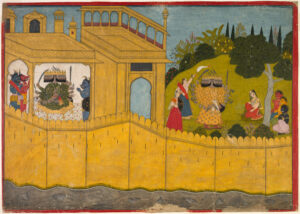 Spread the lovePainting: Ravana addressing Sita in the garden of Lanka, from chapters 53 and 54 of Aranya Kanda (Book…
Spread the lovePainting: Ravana addressing Sita in the garden of Lanka, from chapters 53 and 54 of Aranya Kanda (Book… - Somnath Hore
 Spread the loveSomnath Hore was born in Chittagong (now Bangladesh) in 1921. He was a very talented student since childhood…
Spread the loveSomnath Hore was born in Chittagong (now Bangladesh) in 1921. He was a very talented student since childhood… - Satyen Ghoshal
 Spread the loveGhoshal had artistic talent since childhood. He not only obtained a diploma with distinction from the Government School…
Spread the loveGhoshal had artistic talent since childhood. He not only obtained a diploma with distinction from the Government School… - P. L. NarsimhamurtySpread the loveShri P.L. Lakshmi Nrisimhamurthy is one of the well-known painters of Andhra Pradesh. He was born in Battalanka…
- K. Madhav Menon
 Spread the loveK. Madhavamenon One of the painters from Kerala who has made a notable contribution to contemporary Indian art…
Spread the loveK. Madhavamenon One of the painters from Kerala who has made a notable contribution to contemporary Indian art… - Caves of IndiaSpread the loveWorld famous caves of Ajanta, Chaitya Cave Bihar Cave Ajanta Caves The world-famous caves of Ajanta are located…
- Biren De
 Spread the loveViren De was born on 8 October 1926 in Bengal. He received art education from the Government College…
Spread the loveViren De was born on 8 October 1926 in Bengal. He received art education from the Government College… - Gulam Rasool Santosh | Gulam Rasool Santosh Artist Biography
 Spread the loveGhulam Rasool Santosh was born in Srinagar (Kashmir) on 19 June 1929. His father was in the police…
Spread the loveGhulam Rasool Santosh was born in Srinagar (Kashmir) on 19 June 1929. His father was in the police…


